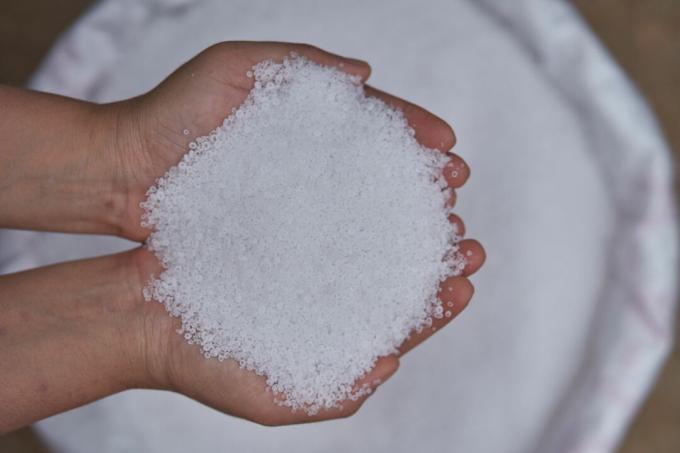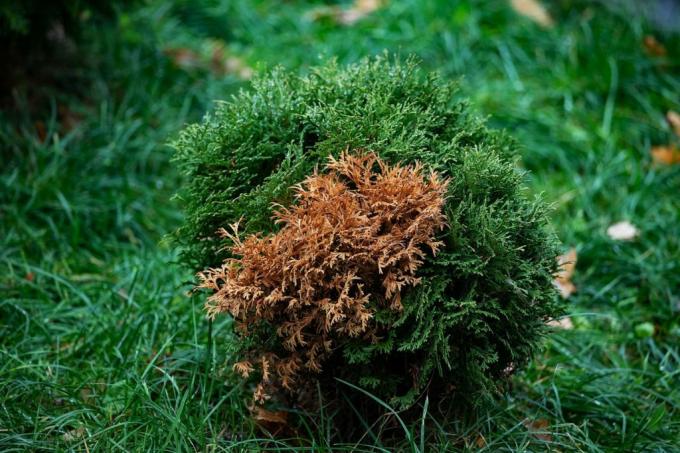Epsom salt is a very special plant fertilizer. We will show you what is characteristic of Epsom salt and what it can be used for in the garden.

Some of you will not know Epsom salts as a fertilizer, but from medicinal uses. On the one hand, we find Epsom salts in so-called heat packs, which generate therapeutic heat, and on the other hand, Epsom salts are used as a laxative. However, it can also be used as a fertilizer. You can find out exactly how this works here.
contents
-
Epsom Salt: What is it?
- Composition of Epsom salt
-
Use Epsom salt as fertilizer
- Epsom salt: what to use and when to use it
- Epsom salt as a fertilizer: how often to use?
- Buy Epsom Salts
Epsom Salt: What is it?
The substance magnesium sulphate (MgSO) is actually hidden behind the name Epsom salt4), a colorless and odorless powder that tastes exceedingly bitter. Hence its name - Epsom salt. Externally, it resembles the normal salt that we know from the kitchen, but Epsom salt consists of completely different substances.
Composition of Epsom salt
As mentioned earlier, Epsom salt is magnesium sulfate, so it's made up of magnesium and sulfate, which, simply put, is sulfur. Now it is also clear which deficiency symptoms Epsom salt can be used for, namely magnesium and sulfur deficiencies.
On average, Epsom salt consists of 16% magnesium and 13% sulfur. However, these levels can vary from provider to provider or depending on the product used. You can always find the exact content of your Epsom salt on the packaging.
Use Epsom salt as fertilizer
Epsom salt is used in universal fertilizers as a source of magnesium. It is either added to fertilizers or used as a pure substance to specifically compensate for a magnesium deficiency.

Epsom salt: what to use and when to use it
Before we get into the application of Epsom salts, let's look at the magnesium in the soil. There are a few factors that affect magnesium that we need to be aware of when fertilizing. This includes the pH value, because the solubility of nutrients in the soil always depends on this. Magnesium is most available at a relatively neutral pH (6 to 8) and is therefore also accessible to plants. However, when the soil becomes acidic or overly basic, the magnesium is no longer available. If you now fertilize with Epsom salt, which consists of magnesium sulphate, you should bear in mind that this lowers the pH value in the soil. If the pH falls below 6, the magnesium solubility is reduced. Then you can in principle fertilize as much as you want - the plant will not receive the substance. For this reason, you should consider a soil test if you have major nutrient supply problems in your garden.
When it comes to magnesium fertilization, you should always keep an eye on another nutrient, namely calcium. If there is a lot of calcium in the soil, this can reduce the availability of other nutrients - for example magnesium, potassium or phosphorus. Therefore, always ensure a balanced nutrient ratio in the soil and avoid one-sided fertilization. Especially often suffer conifers (conifers) in our gardens with a lack of magnesium and this is indicated by yellow or brown discolored needles. Other plants also show magnesium deficiency through yellowing of leaves. First the older leaves turn yellow and slowly the yellowing spreads to the younger ones as well. However, the leaf veins of the discolored leaves remain green and the performance of photosynthesis decreases, because magnesium is an important part of the leaf green, the chlorophyll.

Unfortunately, one cannot clearly infer a magnesium deficiency in conifers just from the discoloration alone. A lack of potassium can also cause the needles to become discolored. Most of us probably know such discolouration and the browning of needles from thuja hedges in the garden. You can apply Epsom salts during the growing season, generally between March and November. Use outside of the growing season is not recommended, as the magnesium sulphate can then simply be washed out and has no effect on our plants.
Since Epsom salt only fertilizes very one-sidedly, a soil test should be carried out before use. In any case, we recommend not only fertilizing with Epsom salt, but also using a balanced organic fertilizer, such as ours Plantura organic universal fertilizer. This contains essential nutrients with which your plants are nourished in a balanced way.
Epsom salt as a fertilizer: how often to use?
For maintenance fertilization with Epsom salts, it is first important to know which soil you have. If your soil is rather light, i.e. very sandy, and water seeps away more quickly, then more magnesium will be washed out. For such light soils, two to three doses of 30 g Epsom salt per square meter are recommended.
If you have heavy soil in the garden that is very loamy and tends to waterlogging, 30 to 50 g Epsom salt per square meter once a season is sufficient for sufficient magnesium fertilization.

You can use the Epsom salt fertilizer in several ways:
- Work the Epsom salts into the soil in solid form and then water the area thoroughly
- Dissolve the Epsom salts in water and water the plants with deficiency symptoms
- Epsom salt can also be foliar applied. Since magnesium is also present in leafy greens, it can easily be supplied in this way. A solution of about 20 ml of liquid Epsom salts in one liter of water is optimal for foliar fertilization
Buy Epsom Salts
Epsom salt is available as a solid fertilizer, but also in liquid form. In principle, Epsom salt is relatively cheap to obtain, sometimes starting at a kilo price of around one euro. Epsom salt is also added to some universal fertilizers for an extra dose of magnesium.
General information about the properties and application of magnesium fertilizers see this article.



